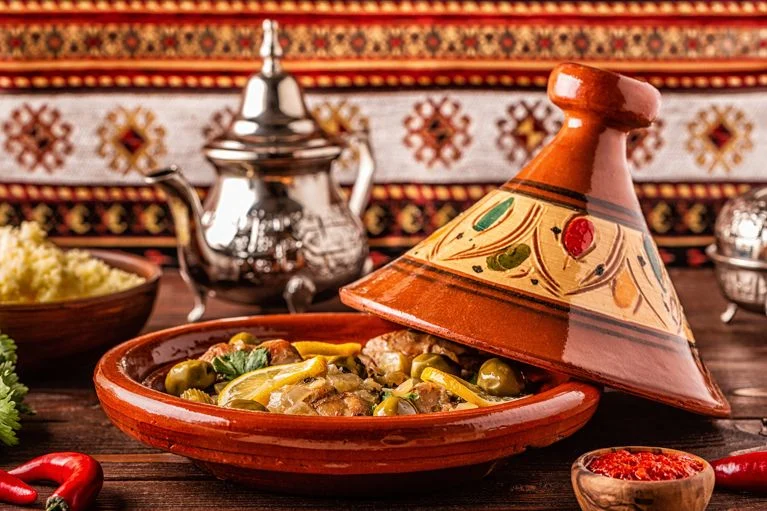preahvihearhotel.com – The tagine, a slow-cooked stew named after the distinctive earthenware pot in which it’s traditionally prepared, is a cornerstone of Moroccan cuisine. This flavorful and aromatic dish, brimming with meat, vegetables, and a symphony of spices, offers a culinary journey to North Africa. This article delves into the history, preparation, variations, and cultural significance of the tagine, exploring why it remains a beloved dish enjoyed worldwide.
A History Etched in Clay: The Origins of the Tagine
The tagine’s history is intertwined with the history of North Africa. The conical lid of the tagine pot is designed to return condensation to the dish, a technique that likely originated out of the need to conserve water in arid regions. The Berbers, the indigenous people of North Africa, are credited with developing the tagine centuries ago. The slow-cooking method allowed them to tenderize tougher cuts of meat and create flavorful meals using locally available ingredients.
The Tagine Pot: A Vessel of Flavor
The tagine pot itself is a crucial element of the dish. Traditionally made of clay, the pot’s wide, shallow base and conical lid create a unique cooking environment. The shape of the lid helps to trap steam and condensation, which then drips back down into the dish, keeping the ingredients moist and flavorful. While traditional clay tagines are still used, modern versions made of ceramic or other materials are also available.
A Symphony of Ingredients: Building Layers of Flavor
The beauty of the tagine lies in its versatility. While there are countless variations, some common ingredients include:
- Meat: Lamb, chicken, and beef are commonly used meats in tagines.
- Vegetables: A wide array of vegetables can be used, including onions, carrots, potatoes, tomatoes, zucchini, and bell peppers.
- Dried Fruit and Nuts: Dried apricots, prunes, raisins, and almonds are often added for sweetness and texture.
- Spices: The spice blend is crucial to the tagine’s flavor profile. Common spices include cumin, coriander, ginger, turmeric, cinnamon, saffron, and paprika.
- Preserved Lemons and Olives: These ingredients add a distinctive tangy and salty flavor.
- Oil: Olive oil is typically used for cooking.
- Liquids: Broth, water, or a combination of both are used to create the stew’s liquid base.
The Art of Preparation: Slow Cooking for Maximum Flavor
Preparing a tagine is a process that requires patience, but the results are well worth the effort:
- Sautéing Aromatics: Onions, garlic, and ginger are typically sautéed in oil until softened.
- Adding Spices: Spices are added to the sautéed aromatics and cooked briefly to release their flavors.
- Adding Meat: The meat is browned and then removed from the pot.
- Layering Vegetables and Other Ingredients: Vegetables, dried fruit, nuts, preserved lemons, and olives are layered in the tagine pot.
- Returning Meat and Adding Liquid: The browned meat is returned to the pot, and broth or water is added.
- Slow Cooking: The tagine is then covered and simmered over low heat for several hours, allowing the flavors to meld and the meat to become incredibly tender.
Variations Across Morocco: Regional Specialties
Different regions of Morocco have their own unique tagine variations. For example:
- Tagine with Lamb and Prunes: This sweet and savory tagine is a classic combination.
- Chicken Tagine with Preserved Lemons and Olives: This tagine offers a tangy and salty flavor profile.
- Vegetable Tagine: This vegetarian option is packed with seasonal vegetables and aromatic spices.
Cultural Significance: A Dish of Sharing and Hospitality
The tagine is more than just a meal; it is a symbol of Moroccan hospitality and sharing. It is often served in a communal setting, with everyone gathered around the tagine pot, scooping out portions with bread.
Beyond Morocco: The Tagine’s Global Journey
The tagine’s popularity has spread beyond Morocco, with variations appearing in other parts of the world. Its unique flavors and slow-cooking method have captured the attention of chefs and food enthusiasts worldwide.
In Conclusion:
The tagine is a culinary masterpiece that embodies the rich history and culture of Morocco. Its aromatic spices, tender meats, and flavorful vegetables create a symphony of tastes and textures that continue to delight palates around the globe. From its humble origins to its current status as a beloved dish worldwide, the tagine remains a testament to the power of slow cooking and the art of combining simple ingredients to create extraordinary flavors.
